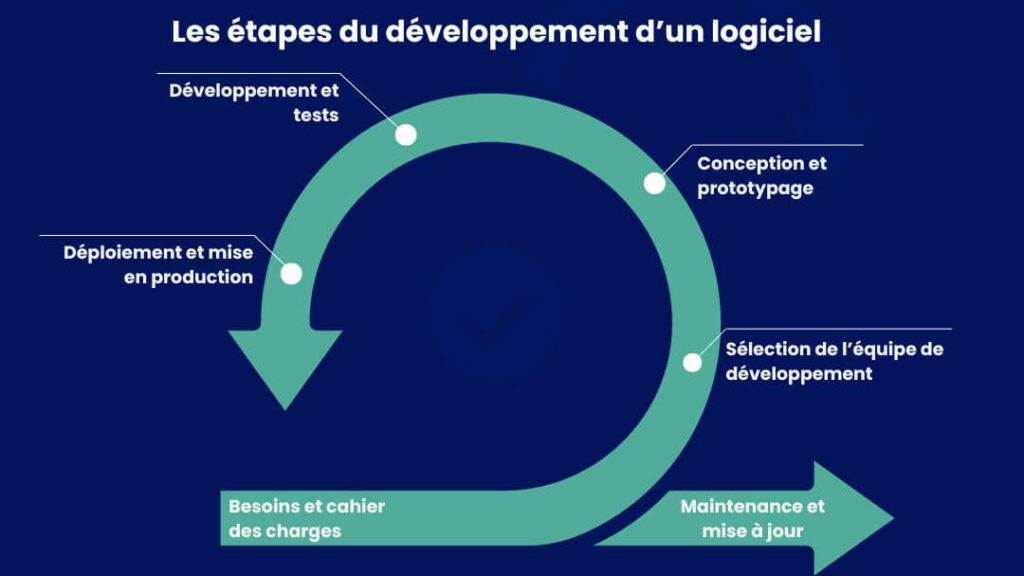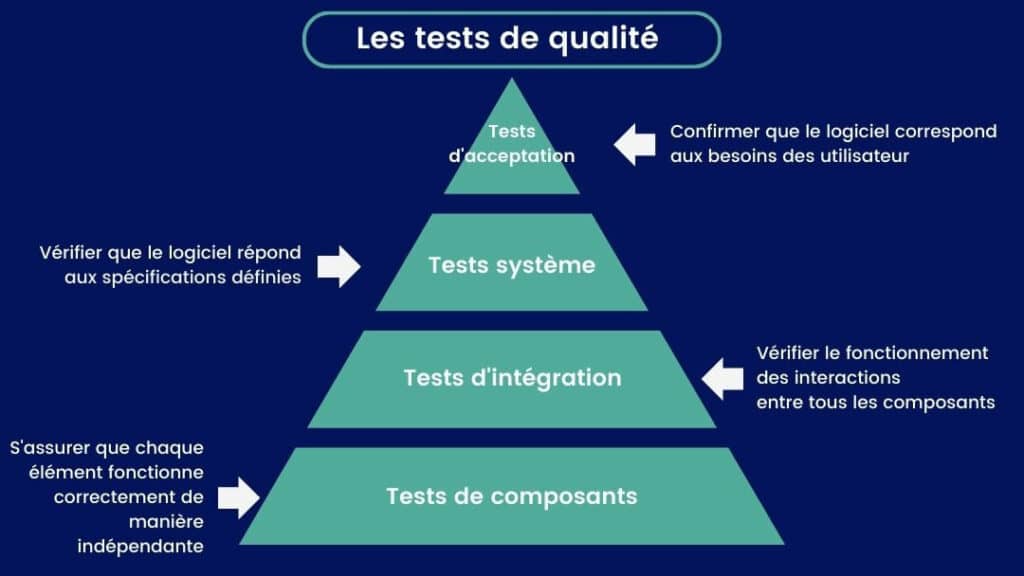Calling on a custom software designer is a strategy that offers multiple advantages for a company. Here’s our complete guide.
What is custom software?
Unlike standard software on the market, customized software is developed to meet the specific needs of an organization. Tailor-made software is the fruit of close collaboration between developers and the customer, translating business constraints into fully customized functionalities.
By using the right tool, organizations can reduce costs, optimize resources, automate processes and boost productivity.
What are the advantages of working with a custom software designer?
The main advantages of using a custom software designer include :
Meeting specific needs

standard software offers a range of functions which, more often than not, skim the surface of the subject and fail to meet the organization’s specific needs. On the other hand, customized software will be perfectly adapted to your constraints and business processes.
Flexibility and scalability

Tailor-made software is your personalized solution, which can evolve as your needs change. Fine-tune the software by adding, deleting or modifying features to stay as close as possible to your objectives.
Total customization

In addition to the software’s customizable features, which enable it to evolve according to your needs, the customization of its interface according to your corporate charter is also an important element. It reinforces your brand image and your employees’ sense of belonging.
Seamless integration

Tailor-made software is developed to integrate seamlessly with other applications and infrastructures used in the company, to avoid any disruption to users.
Dedicated support and maintenance

Your custom software developer will probably offer you support and maintenance. In the event of a problem, breakdown or development project, you’ll have access to a responsive service with full knowledge of your interface.
What are the steps involved in creating a successful custom software project?
We have broken down the creation of custom software into 6 key stages:

Step 1 - Defining requirements and specifications

This first step is fundamental, as it lays the foundation for everything that follows and determines the success of the software project.
Identifying and documenting required functionalities
It’s essential to define the software’s expected functionality clearly and precisely. This requires in-depth discussions with all stakeholders, from end-users to decision-makers. Once identified, these functionalities must be recorded in detail to avoid any confusion or misunderstanding in the future.
At Qim info, we understand that our customers may find it difficult to define their needs. That’s why we provide you with a Business Analyst whose role is to understand your exact requirements and expectations.
Determining target users and their needs
Developing good custom software requires understanding who will be using it. We need to define the different user profiles and identify their specific needs, behaviors and expectations with regard to the software.
The importance of a long-term vision
Although the emphasis is on satisfying immediate needs, it’s also a good idea to think about the software’s potential long-term evolution. This long-term perspective is crucial to the design of a flexible, scalable solution.
Step 2 - Selecting the development team

To ensure the smooth development of your custom software, it’s imperative to surround yourself with qualified collaborators.
Finding the right partner or hiring internally
Depending on the size and complexity of the project, you have the choice between setting up an in-house team or calling in a specialized external partner. Each of these options offers distinct advantages: an external partner can bring cutting-edge expertise, while an in-house team benefits from prior knowledge of the company’s culture and processes.
At Qim info, to respond to each of these options, we work either in delegation mode, or in project mode with the Centre d’expertises teams.
The importance of experience and specialisation
Experience plays a crucial role. A team that has already worked on similar projects will be better prepared to anticipate challenges and propose effective solutions. What’s more, some projects require specific skills.
With over 10 years’ experience and 50 customers who have placed their trust in us, our Custom Software Development department puts at your disposal a team made up of developers, a Business Analyst, a UI/UX designer, a tester and a Technical Leader.
Communication as the key to success
Good communication between developers and customers is essential. It ensures that the project stays on track and meets the requirements initially defined, or keeps pace with developments. Qualified collaborators are indispensable for the proper development of your custom software.
Step 3 - Design and prototyping

This phase of the process is particularly stimulating, as it allows you to visualize the final result of your software.
Translating needs into mock-ups and functional prototypes
Before starting the actual development, it’s important to make your vision a reality. This involves the creation of HD/LD mock-ups, wireframes or functional prototypes to provide a concrete representation of how the software will look and function.
Validating ideas before full development
Prototyping is an essential step in testing and validating your ideas. It enables rapid feedback from users and stakeholders, which may require adjustments before moving on to the full development phase. At Qim info, we consider our customers to be Product Owners in their own right, as their feedback is needed to fine-tune the software’s functionality.
Recommended tools and methodologies
Working from tools like Figma, Sketch or Adobe XD can simplify the process. As far as methodologies are concerned, approaches such as Design Thinking focus the design process on user needs.
You can also adopt Domain-Driven Design (DDD) in your development method. This approach focuses on harmonizing the software with the specificities and intricacies of the business domain in question. By focusing on business logic, DDD ensures that software evolves in sync with domain developments, guaranteeing continuous adaptation to business needs.
Step 4 - Development and testing

Nothing is left to chance at this stage of development.
Opt for an agile methodology for frequent feedback
The choice of an agile methodology, such as Scrum or Kanban, favors continuous development with regular feedback from the various stakeholders. This ensures that the product remains constantly in tune with user needs, and is flexible enough to adapt to new priorities. At Qim info, we’re firmly committed to agility, and this approach has been at the heart of our collaboration with our customers for 10 years now.
The importance of testing to ensure quality
Testing software is an essential step in guaranteeing its quality and reliability, from unit testing to integration and acceptance testing, to ensure it meets user requirements.

Integrations and compatibility with other systems
In a technological environment where everything is connected, it’s vital that the new software blends in naturally with other systems or platforms already in place. This integration may involve the use of application programming interfaces (APIs), the ability to handle different types of data, or compatibility with specific operating systems.
Visit
our article on Clean Code
which summarizes the best practices for writing readable, easy-to-handle code.
Step 5 - Deployment and production launch

You’re there! Your software is operational, but the work doesn’t stop there.
Preparing the ground for software launch
Before launching the software, it’s essential to set up the required infrastructure, configure production environments and ensure that everything is ready for deployment. For large-scale projects, this stage includes an organized handover to the operational teams. These teams play an important role in managing and maintaining the software in production. It’s vital to involve them in the process as early as possible, keeping them up to date with the technical aspects and training them in the new practices to ensure that the transition is secure and efficient.
Training end-users
To ensure that end-users successfully adopt the software, it is imperative to train them. This can include training sessions, the provision of user manuals or the creation of online support. At Qim info, we attach great importance to this step and pay particular attention to it. We involve key users in creation and demo workshops

Ensuring a smooth handover
Implementing new software can cause inconvenience in everyday tasks. To limit these inconveniences, it’s essential to ensure a smooth transition by communicating clearly and offering constant support during deployment.
Step 6 - Maintenance and updates

Once your customized software has been deployed, Qim info provides a hosting solution and maintenance to guarantee its security and compliance.
The need for regular monitoring
Once the software has been deployed, it needs constant attention and performance monitoring to anticipate bugs and potential security incidents.
Planning updates to stay current
To ensure that the software remains efficient and in phase with business needs, updates are planned, integrating new functionalities.
Managing user feedback and adjusting accordingly
Users and their professional activities are at the heart of all software. Their feedback, whether critical, suggestive or focused on improvement, is essential to guide future updates and ensure that the product remains fit for purpose.
And if you’d like to learn more about custom software development, check out our detailed comparison of the Angular and React frameworks .
How much does it cost to hire a custom software designer?
Determining the cost of software development is a complex process that depends on a number of factors. First of all, software complexity and functionality play a crucial role. Simple software with basic functionality will be less expensive to develop than software with advanced features, database integrations and sophisticated user interfaces. The size and expertise of the development team are also factors to consider. While larger, more experienced teams may charge higher rates, they can deliver better quality work and meet tighter deadlines. If the software requires customization or specific integrations, this can also increase costs. It is essential not to forget or underestimate the costs of ongoing maintenance, updates and technical support after the initial development. When it comes to hosting, cloud solutions can be advantageous in terms of maintenance costs. It’s a good idea to request several quotes from software development specialists, outlining your specific needs in detail, including your functional and technical requirements, budget and timeframe. As each project is unique, it is important to evaluate them individually to obtain an accurate estimate of the development cost.
Who to contact for custom software development?
To guarantee successful software development, it’s crucial to work with a team of qualified software specialists. Here are a few options to consider when looking for a competent team for your project:
- Companies specializing in software development: Many companies focus on the development of tailor-made software, adapted to the specific needs of their customers.
- Agencies specializing in web and mobile development: If your project involves the creation of a website or a standard mobile application, you can call on agencies specializing in this field.
- Freelancers and independent consultants: Hiring freelancers or independent consultants with software development expertise is another viable option.
- Use in-house resources: If your company already has a team of in-house developers, you can entrust the software development project to them. Make sure they have the skills and resources needed to complete the project.
- Professional networks: You can also tap into your professional networks to obtain recommendations or referrals to reliable, experienced software development teams.
Before making a decision, it’s important to check the experience, technical skills, customer references and previous project portfolio of the proposed development team. This will ensure that your project is in safe hands and that your objectives are successfully met.
Qim info creates your customized software
For 20 years, Qim info has been supporting you in the development of your customized software. Flexible and adaptable, with over 120 customers placing their trust in us, Qim info stands out for its ability to understand the precise needs of each customer, and help you find the missing piece in your project.
Our services are many and specific – technical support, infrastructure management, cybersecurity, data management, Cloud solutions, IT consulting, project management… And in our Center of expertise,a team of development specialists is there to help you produce a customized software application for your company.







